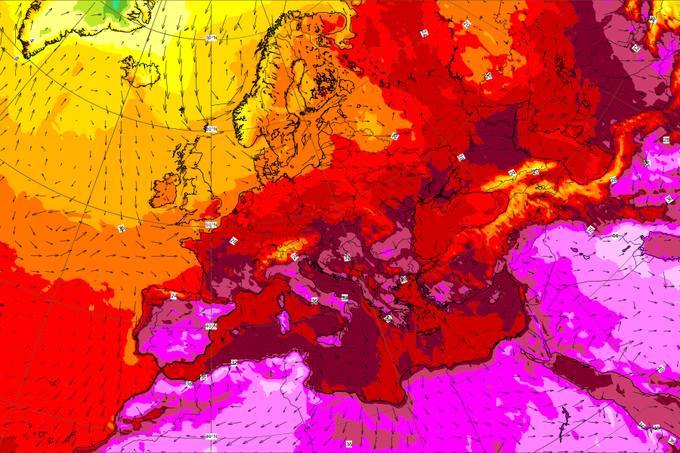Europe is experiencing one of its hottest summers on record, with relentless heatwaves sweeping across the continent. From wildfires in Greece to droughts in Italy and record-breaking temperatures in France, the signs are impossible to ignore.
But what’s really behind this scorching summer? Is it just a seasonal anomaly, or something deeper tied to climate change? In this article, we break down the key drivers of Europe’s current heatwaves, including shifts in jet streams, warming oceans, and greenhouse gas emissions.
Whether you’re sweating through the heat or simply trying to understand the science, we’ll explain how global climate trends are amplifying extreme weather—and what it could mean for future summers across Europe. Let’s dive into the data behind the heat.
Read More: What’s Causing Europe’s Scorching Summer? Heatwaves Explained
Why Is Europe Experiencing Such Extreme Heat?
Europe is in the grip of a record-breaking summer, with July beginning as the hottest week ever recorded, according to the World Meteorological Organization (WMO).
This follows a historically hot June, driven by the dual impact of climate change and El Niño—a natural climate phenomenon that warms the Pacific Ocean and influences global weather patterns.
This month, parts of southern Europe have endured scorching temperatures due to a persistent heat dome, a meteorological pattern where high pressure traps hot air over a region.
Contributing to the intensity are powerful high-pressure systems, including Cerberus and Charon—named after figures from Greek mythology. These systems pushed temperatures in Greece, Spain, and Italy above 45°C (113°F).
The European Centre for Medium-Range Weather Forecasts noted that a marine heatwave in the Atlantic Ocean, particularly affecting waters near North America and Europe, may be amplifying the extreme weather.
Warmer ocean surfaces influence atmospheric circulation and raise temperatures in the overlying air masses.Experts warn that climate change, fueled by greenhouse gas emissions from burning fossil fuels, is a primary driver behind the increased frequency, intensity, and duration of heatwaves globally.
“Climate change across the globe is increasing the frequency, intensity and duration of heatwaves,” said Akshay Deoras, a research scientist at the University of Reading’s National Centre for Atmospheric Science. “It’s effectively making heatwaves into severe heatwaves.”
As the continent confronts the consequences of a warming planet, meteorologists and scientists continue to urge governments and communities to prepare for more frequent and dangerous heat events in the years ahead.
What are anticyclones?
Anticyclones are large-scale weather systems characterized by high atmospheric pressure at their center, around which air flows in a clockwise direction in the Northern Hemisphere and counterclockwise in the Southern Hemisphere.
Unlike low-pressure systems that often bring clouds and precipitation, anticyclones typically lead to clear skies, dry conditions, and stable weather. This happens because the sinking air in an anticyclone suppresses cloud formation.
During summer, anticyclones can become dangerous contributors to heatwaves, as they trap warm air near the surface, intensify sunlight, and prevent cooler air or storms from moving in.
When these high-pressure systems remain stationary for days or weeks—forming what’s known as a heat dome—they can cause extreme and prolonged heat, like the kind currently affecting parts of Europe.
Which Countries Have Been Most Affected by Europe’s Heatwaves?
The summer heatwaves have taken a particularly harsh toll on southern and central Europe, with several countries facing dangerous temperatures, health emergencies, and environmental crises.
Italy has been one of the worst-hit nations, with temperatures surpassing 45°C (113°F) in areas like Sardinia and Sicily. The government issued red alerts in multiple cities, warning of severe health risks, especially for the elderly and vulnerable.
In Greece, the heatwave intensified the risk of wildfires, prompting evacuations near Athens and on various islands. Public services were disrupted, and tourists were urged to avoid outdoor activities during peak heat hours.
Spain experienced sustained high temperatures, particularly in Andalusia and central regions, where thermometers hit 44°C (111°F). The heat strained healthcare systems and sparked wildfires in rural areas.
France, especially in the southeast, saw abnormally hot conditions. Urban centers struggled with the urban heat island effect, and national weather services issued multiple heat alerts.
Portugal faced scorching conditions along with drought warnings, as both inland and coastal areas experienced relentless heat.
Other affected countries include Turkey, Croatia, and parts of the Balkans, where rising temperatures disrupted daily life and heightened fire risks. The pattern highlights a troubling trend: extreme heat is no longer confined to southern Europe—it’s spreading further north and becoming the new normal.
How Long Will the Heatwave Last?
The European Centre for Medium-Range Weather Forecasts (ECMWF) reports that the current spell of extreme temperatures is expected to ease by Thursday, as a cooler air mass from the north begins to move across the continent. However, this respite may be short-lived.
Meteorologists warn that another surge of intense heat is likely to return by Sunday and continue through Tuesday, bringing renewed risk of high temperatures across much of Europe.
Experts caution that unless the heat dome—the high-pressure system trapping hot air over the region—is disrupted, the continent could face additional waves of extreme heat in the coming weeks.

The situation underscores the increasing volatility and persistence of climate-driven weather extremes.
What’s Expected in the Coming Days Across Southern Europe?
Southern Europe remains under the grip of intense heat, with Greece, Italy, and Spain facing extreme weather conditions in the days ahead.
In Greece, temperatures are forecast to reach between 41°C and 45°C (105°F to 113°F). In response, the Ministry of Culture has announced the closure of all archaeological sites—including the Acropolis in Athens—from 12:00 p.m. to 5:30 p.m. (09:00 to 14:30 GMT) until Sunday, to protect visitors and workers from heat-related risks.
Italy will continue to see scorching temperatures, particularly in the central and southern regions. Sardinia is expected to reach 40°C (104°F), while Palermo could climb to 41°C (105°F). However, a slight reprieve is anticipated in the north, where the Charon anticyclone is expected to weaken, easing conditions.
In Spain, while parts of the northeast may benefit from storms and the western Canary Islands brace for strong wind gusts, the heat will persist elsewhere. Seville and Córdoba, in the south, are projected to hit 38°C (100°F) by Sunday, continuing the trend of dangerously high temperatures.
Frequently Asked Questions (FAQs)
Why is it so hot in Southern Europe this summer?
The extreme heat in Southern Europe is primarily driven by a combination of climate change and a heat dome. A high-pressure system, like Cerberus and Charon, traps warm air over the region, leading to prolonged periods of intense heat. Additionally, global phenomena like El Niño and rising sea surface temperatures in the Atlantic Ocean contribute to more frequent and severe heatwaves.
How long will the heatwave last?
The current heatwave in Southern Europe is expected to ease by Thursday, as cooler air moves in from the north. However, another wave of heat is likely to return by Sunday, potentially lasting through Tuesday. The persistence of these heatwaves depends on the stability of the high-pressure system.
What temperatures are expected in Greece in the coming days?
Temperatures in Greece are expected to range between 41°C and 45°C (105°F to 113°F) in the coming days. As a precaution, the Ministry of Culture has ordered the closure of major archaeological sites, including the Acropolis in Athens, between 12:00 p.m. and 5:30 p.m. (09:00 to 14:30 GMT) until Sunday.
How hot will it get in Italy?
Italy will experience intense heat, especially in the central and southern regions. Sardinia is expected to reach 40°C (104°F), while Palermo could see 41°C (105°F). Relief is anticipated in the north, where the heatwave is expected to weaken.
Will Spain see any relief from the heat?
Some areas in Spain will experience relief in the coming days. Storms are forecast for the northeastern regions, and the Canary Islands will experience strong winds. However, Seville and Córdoba in the south are expected to reach 38°C (100°F) by Sunday, with no significant relief in sight for the southern cities.
Are there any safety precautions for dealing with this heat?
It’s crucial to stay hydrated, avoid direct sunlight during peak hours (12 p.m. to 5 p.m.), and seek air-conditioned spaces when possible. If you’re in areas with high temperatures, follow local advisories, wear lightweight and breathable clothing, and avoid strenuous activities during the hottest parts of the day.
Conclusion
The ongoing heatwave in Southern Europe serves as a stark reminder of the growing intensity and frequency of extreme weather events, driven largely by climate change. With Greece, Italy, and Spain experiencing dangerously high temperatures, authorities are implementing measures to protect public safety, including closing historical sites and advising the public to limit outdoor activities.

